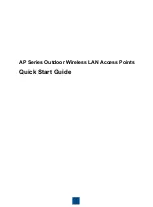
Working with VSCs
VSC configuration options
4-11
Once a client is associated at 5 GHz, the AP will not respond to any 2.4 GHz probes from
the client as long as the client’s signal strength at 5 GHz is greater than -80 dBm (decibel
milliwatt). If the client’s signal strength falls below -80 dBm, then the AP will respond to
2.4 GHz probes from the client without delay.
Note
To support band steering, one radio must be configured for 2.4 GHz operation and the
other for 5 GHz operation.
Band steering is temporarily suspended when the radio configured for 5 GHz operation
reaches its maximum number of supported clients.
Wireless clients
Max clients/Max clients per radio
Specify the maximum number of wireless client stations that can be associated with this
SSID at the same time. On dual radio products the limit applies separately on each radio.
Allow traffic between wireless clients
Use this option to control how users that are connected to the same VSC can communicate
with each other. The following settings are available:
No:
Blocks all user-to-user communication.
802.1X:
Only authenticated 802.1X users can communicate.
All:
All authenticated and unauthenticated users can communicate. Default setting.
IPV6:
Only authenticated users using IP version 6 can communicate.
Configuring communication between different VSCs
Communication between users connected to different VSCs can only occur if the same
VLANs are assigned in the
VSC egress mapping
option for both VSCs.
For example, to support traffic between authenticated users on two different VSCs, the
Authenticated
option under
VSC egress mapping
must be set to the same VLAN on both
VSCs.
In addition, the following rules govern how traffic is exchanged:
Unicast traffic exchanged between VSCs on the
same
radio is controlled by the setting of
the receiver’s VSC.
Unicast traffic exchanged between VSCs on
different
radios is controlled by the setting
of the sender’s VSC.
Multicast traffic exchanged between VSCs is always controlled by the setting of the
sender’s VSC.
APs with a single radio
APs with dual radios
Summary of Contents for E-MSM310
Page 2: ......
Page 3: ...HP MSM3xx MSM4xx Access Points Management and Configuration Guide ...
Page 14: ...Contents xii ...
Page 26: ...Introduction Online documentation 1 12 ...
Page 51: ...Wireless configuration Radio configuration 3 9 E MSM460 and E MSM430 ...
Page 52: ...Wireless configuration Radio configuration 3 10 MSM422 ...
Page 53: ...Wireless configuration Radio configuration 3 11 MSM410 ...
Page 54: ...Wireless configuration Radio configuration 3 12 MSM335 radio 1 and 2 ...
Page 55: ...Wireless configuration Radio configuration 3 13 MSM335 radio 3 ...
Page 56: ...Wireless configuration Radio configuration 3 14 MSM320 ...
Page 57: ...Wireless configuration Radio configuration 3 15 MSM310 ...
Page 112: ...Working with VSCs Quality of service QoS 4 28 ...
Page 134: ...Network configuration 802 1X supplicant 5 22 ...
Page 196: ...Regulatory information B 16 ...
Page 208: ...Resetting to factory defaults Factory defaulting ruggedized products D 6 ...
Page 209: ......
















































